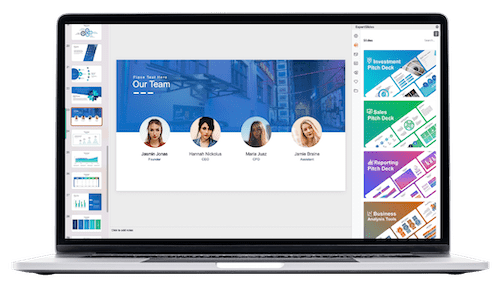History Presentation Template – Step Back in Time
Table of Contents
History presentation templates are a valuable resource for educators, historians, and individuals seeking to convey historical narratives in an engaging and visually appealing manner. These templates offer a structured approach to organizing and presenting historical data, enabling users to craft captivating and informative presentations that resonate with their audience. Regardless of the context, whether teaching a history class, delivering a lecture at a museum, or presenting at a conference, history presentation templates provide a reliable means of creating a compelling and educational presentation that effectively conveys the significance of historical events.
Key Takeaways
- Historical presentation templates can help bring the past to life and captivate your audience
- Using historical imagery and fonts can add authenticity and depth to your presentation
- Creating a timeline with historical events can help visualize the progression of history
- Incorporating vintage photos and artifacts can make your presentation more engaging and immersive
- Storytelling techniques can help connect your audience to the historical narrative and make the information more memorable
Exploring the Past: Using Historical Imagery and Fonts

One of the key elements of a history presentation template is the use of historical imagery and fonts. By incorporating images and fonts that are reminiscent of the time period you are discussing, you can create a visual experience that transports your audience back in time. For example, if you are discussing the Renaissance, you might use images of famous artworks from that period, such as Leonardo da Vinci’s Mona Lisa or Michelangelo’s David.
You could also use fonts that mimic the handwriting styles of the time, adding an authentic touch to your presentation. In addition to using historical imagery and fonts, you can also incorporate historical maps, documents, and other visual artifacts into your presentation. These elements can help to provide context and depth to your presentation, allowing your audience to better understand the time period and events you are discussing.
Step Back in Time: Creating a Timeline with Historical Events
Another effective way to use history presentation templates is to create a timeline of historical events. Timelines are a great way to visually organize and present the sequence of events in a particular time period, making it easier for your audience to understand the historical context of the topic you are discussing. You can use the timeline feature in your presentation template to create a chronological sequence of events, adding images and descriptions to each event to provide additional context and detail.
When creating a timeline, it’s important to consider the significance of each event and how it relates to the overall narrative of the time period. By carefully selecting and arranging the events on your timeline, you can create a compelling visual representation of history that helps your audience understand the progression of events and their impact on the world.
Bringing History to Life: Incorporating Vintage Photos and Artifacts
| Slide Number | Content | Notes |
|---|---|---|
| 1 | Title Slide | Introduce the topic and set the tone for the presentation |
| 2 | Introduction to the Time Period | Provide background information and context |
| 3 | Main Events | Highlight key events and their significance |
| 4 | Cultural Aspects | Explore the art, music, and literature of the time period |
| 5 | Impact on Society | Discuss how the time period influenced society |
In addition to using historical imagery and timelines, you can also bring history to life in your presentation by incorporating vintage photos and artifacts. Vintage photos can provide a glimpse into the past, allowing your audience to see what life was like during a particular time period. By including photos of historical figures, events, and everyday life, you can help your audience connect with the people and events you are discussing on a more personal level.
Similarly, incorporating artifacts from the time period you are discussing can add a tangible element to your presentation. Whether it’s a piece of clothing, a tool, or a document from the past, these artifacts can help to make history feel more real and immediate for your audience. By including these elements in your presentation, you can create a multi-sensory experience that engages your audience on a deeper level.
Captivating the Audience: Using Storytelling Techniques in Historical Presentations

One of the most powerful ways to engage your audience in a history presentation is by using storytelling techniques. By framing historical events as stories with compelling characters, conflicts, and resolutions, you can create a narrative that draws your audience in and keeps them engaged throughout your presentation. You can use storytelling techniques such as foreshadowing, suspense, and character development to create a sense of drama and intrigue in your presentation.
In addition to using storytelling techniques, you can also incorporate primary sources and personal accounts into your presentation to add authenticity and emotional resonance. By including letters, diaries, speeches, and other firsthand accounts from people who lived during the time period you are discussing, you can provide a more intimate and human perspective on historical events. This can help your audience connect with the people and events of the past on a more personal level, making history feel more relevant and meaningful to them.
Tips for Designing a Visually Engaging History Presentation
When designing a history presentation, there are several tips you can keep in mind to create a visually engaging and effective presentation. First, consider using a consistent color scheme and design elements throughout your presentation to create a cohesive visual experience. This can help to create a sense of unity and organization in your presentation, making it easier for your audience to follow along and understand the information you are presenting.
Second, be mindful of the layout and placement of images, text, and other visual elements in your presentation. By carefully arranging these elements on each slide, you can create a visually appealing and easy-to-follow presentation that keeps your audience engaged. Consider using visual hierarchy to prioritize important information and guide your audience’s attention to key points in your presentation.
Finally, don’t be afraid to experiment with different design techniques and styles to create a unique and memorable presentation. Whether it’s using animation, interactive elements, or unconventional layouts, thinking outside the box can help you create a presentation that stands out and leaves a lasting impression on your audience.
Inspiring and Educating with Historical Presentation Templates
In conclusion, history presentation templates are a valuable tool for inspiring and educating audiences about the past. By using historical imagery and fonts, creating timelines of historical events, incorporating vintage photos and artifacts, using storytelling techniques, and designing visually engaging presentations, you can create compelling and informative presentations that bring history to life for your audience. Whether you are teaching a history class, giving a lecture at a museum, or presenting at a conference, history presentation templates can help you share the stories of the past in a way that captivates and educates your audience.
With careful planning and thoughtful design, you can create presentations that inspire curiosity about history and leave a lasting impact on your audience.
FAQs
What is the History Presentation Template – Step Back in Time?
The History Presentation Template – Step Back in Time is a pre-designed presentation template that allows users to create visually appealing and informative presentations on historical topics.
What are the key features of the History Presentation Template – Step Back in Time?
The template includes a variety of slide layouts, historical-themed graphics and images, and customizable text boxes. It also offers a cohesive color scheme and font selection to maintain a professional and engaging look throughout the presentation.
Who can use the History Presentation Template – Step Back in Time?
The template is suitable for students, educators, historians, and anyone else looking to create a presentation on a historical topic. It can be used for classroom presentations, historical research projects, or professional presentations on historical subjects.
How can I access the History Presentation Template – Step Back in Time?
The template can be accessed and downloaded from various presentation software platforms, such as Microsoft PowerPoint, Google Slides, or Apple Keynote. Users can then customize the template to fit their specific historical topic and content.
What are the benefits of using the History Presentation Template – Step Back in Time?
Using a pre-designed template can save time and effort in creating a visually appealing presentation. The cohesive design elements and historical-themed graphics can also help to engage and captivate the audience, enhancing the overall impact of the presentation.
Get 15+ Mio. PowerPoint Assets - FREE SIGN-UP

Sign up for free to our PowerPoint extension, ExpertSlides. Everything you need, directly in PowerPoint. No credit card required.
Related Posts
Recent Posts
Main Menu
Knowledge base
Useful Links






